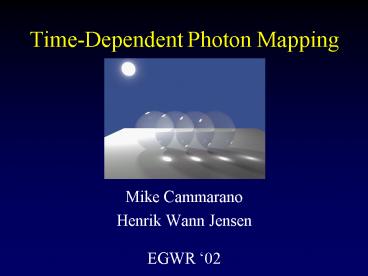TimeDependent Photon Mapping - PowerPoint PPT Presentation
Title:
TimeDependent Photon Mapping
Description:
Time-Dependent Photon Mapping. Mike Cammarano. Henrik Wann Jensen. EGWR 02. Standard Photon Map ... For 100 photons emitted from 100W source, each photon ... – PowerPoint PPT presentation
Number of Views:74
Avg rating:3.0/5.0
Title: TimeDependent Photon Mapping
1
Time-Dependent Photon Mapping
- Mike Cammarano
- Henrik Wann Jensen
- EGWR 02
2
Standard Photon Map
- Two-pass algorithm
- Photon trace
- Rendering
3
First Pass - Photon Trace
For 100 photons emitted from 100W source, each
photon initially carries 1W. Propagate this
radiant flux through scene using MC methods.
4
Estimating incident flux
- At any patch of surface, we can estimate the
incident flux
Just average the contributions of all the
photons that hit the patch.
5
A Photon
- For each surface interaction, we store
- struct photon
- float x,y,z // position
- char power4 // power (RGBE)
- char phi, theta // incident direction
- short flag
6
Photon Storage
- Store this information about surface
- interactions in photon map (kd-tree)
- Photon storage is decoupled from geometry
7
Second Pass - Rendering
- Estimate flux incident at a surface point based
on nearby photons.
8
Radiance Estimate
Expand ball until it contains some reasonable
number of photons. Use intersection with plane
to estimate area of surface patch.
9
Radiance Estimate
10
What About Motion?
11
One Approach
- Render lots of intermediate frames independent
of one another.
12
Average Intermediate Frames
13
Expensive
- Only some areas need to be densely sampled in
time. - Need MANY intermediate frames to get smooth
results.
14
Adaptive Sampling
- Want to sample densely in time only for the
pixels that need it. - Easy with ray tracing. Can trace each ray for a
different time in the interval. Cook84
15
Photon Map
- We cant rebuild the photon map for every eye-ray
with a different time! - We would like to do DRT with photons, too.
- Given rays sampling various times and photons
representing lighting at various times, how do we
match them up?
16
Photons distributed in time
- t0.0 t0.5 t1.0
17
Energy
- Radiant Flux Radiant Energy
18
Time-Dep. Radiance Estimate
19
Static surface, no occlusion
20
Photons in time
- Want average radiance ( ? dt )
21
Time distribution
22
Average over time
23
Case 1
For stationary surfaces with unobstructed
visibility through the entire view interval, we
can ignore time distribution of photons.
24
Plane Moving Down
t0.0 t0.5 t1.0
25
Photon Visualization
t0.0 t0.5 t1.0
26
A Trickier Case
Average of independent frames Distributed
photon times
t0.0 t0.5 t1.0
27
Examples
28
Problem
- A given patch of surface is only visible through
a particular pixel for a small portion of the
total time interval. - Its brightness during that visible interval
should depend only on the photons reaching it
during that narrow window of time not the
average over all times.
29
Distribution in Time
30
Narrow Window in Time
- Integrate over small visible interval.
31
Comparison
32
Performance
- Path tracing 9 hrs
- Average of independent frames 47 sec
- TDPM 43 sec
- Our worst case we get essentially no benefit
from adaptive sampling doesnt cost much to
oversample blue background. - Try it in front of 107 polygon forest
33
Summary of Method
IF ray-path from eye is unaffected by
motion Can integrate over entire time interval
?t 1. (Use all the spatially nearby photons
in the estimate) ELSE Integrate over shorter
visible interval. Can use several criteria for
choosing ?t adaptively 1. ?t lt user-specified
Max?t 2. ?t chosen to use only
k-nearest-photons-in-time 3. ?t lt time spanned
by the photons
34
Truck Scene
35
Effect
36
Comparison
Average of 9 frames - 316 seconds
37
Comparison
Our method 72 seconds
38
Comparison
Ignoring case for eye-paths with movement
39
Conclusion
- Can incorporate correct global illumination via
photon mapping in a ray-tracer that adaptively
samples in time. - Computing photon map with time-dependence
requires little or no added cost beyond photon
mapping for the corresponding still scene. - Better performance than alternative methods for
animated global illumination.































